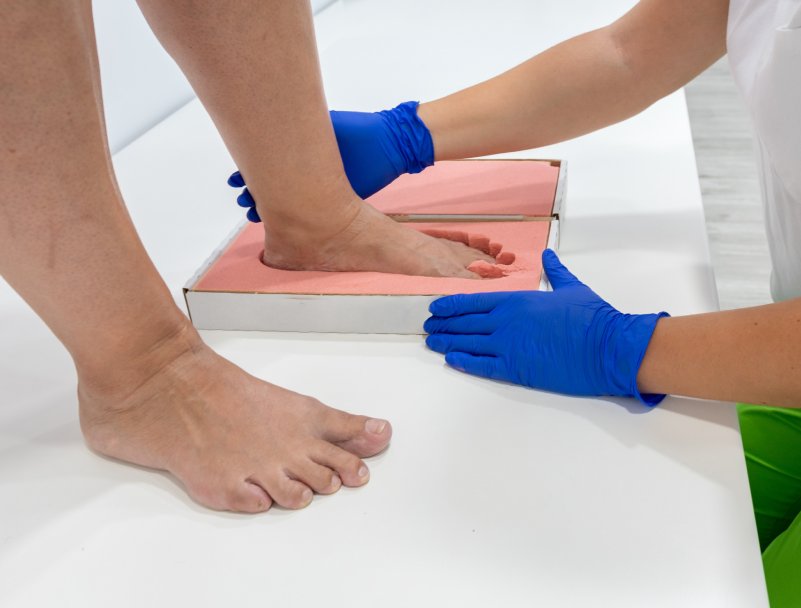Find Orthotics Near You
What Are Orthotics?
Orthotics are medical devices that are custom fitted to your feet to correct foot problems. They achieve this by aligning or supporting the proper position of the feet. Orthotics often help with pain management, including knee pain, ankle pain, heel pain and foot pain. These devices are often inserted into the bottom of your shoes. They can also correct deformations, increase a person’s mobility, or provide support after an injury, surgery, or treatment.

Who Needs Orthotics?
If you suffer from knee, ankle, or foot pain, custom orthotics may help alleviate some of that pain.
Foot pain is often caused by issues and conditions such as:
- Foot deformities
- Lack of arch support (flat feet)
- High arches
- Plantar fasciitis
- Diabetes
- Rheumatoid arthritis and osteoarthritis
- Bunions and hammer toes
- Bursitis
- Injuries
These conditions frequently cause tissues such as muscles, tendons, joints, ligaments, and bones in the feet to become misaligned, strained, or out of place. A custom orthotic can gently but firmly support or correct the position of these tissues.
Orthotics may also be prescribed to reduce leg pain and back pain, and may be designed to support the ankles as well. In some cases, orthotics may be recommended for a short period of time to support recovery from surgery or other treatments. However, orthotics are usually recommended for long-term support of the feet.
The Difference Between Shoe Inserts and Orthotics
Shoe inserts (or “off-the-shelf orthotics or inserts”) are foot pads that can be purchased at stores, including health stores, pharmacies, and sporting goods stores. They are not customized to your feet, and their purpose is usually to make walking or standing more comfortable by cushioning the bottoms of your feet. For general or mild foot pain, a shoe insert may provide relief.
Foot orthotics, on the other hand, are customized to your feet. They are medical-grade devices prescribed to correct bio-mechanical issues of the feet. Foot orthoses are often used after store-bought inserts have not helped correct an issue or relieve symptoms.
Prescribed orthotics are more expensive than off-the-shelf foot inserts. In some cases, medical insurance may cover some or all of the costs of orthotics—be sure to check directly with your insurance provider to find out what your coverage includes. While the cost is higher, the durability of the materials and the specific custom-made design often make them a worthwhile investment for those experiencing foot pain or difficulty standing and walking.
How Orthotics Are Made
A podiatrist is a medical specialist who treats conditions affecting the feet. They can design and order custom orthotic devices and know a great deal about the various types of orthotics and what works best.
Custom-fitted orthotics require a few steps to create. First, you will see the podiatrist for an exam, which may include a physical exam of your feet, and observations made about how you stand, walk, or run. Depending on the condition of your feet, a podiatrist may also order scans such as MRIs or x-rays.
Depending on the medical advice of your podiatrist, it may be recommended that you invest in custom-made orthotics to correct issues and relieve symptoms, such as pain. Additionally, you may be advised to attend physical therapy, take over-the-counter anti-inflammatory medication, or perform certain stretches or exercises at home.
Once your podiatrist has determined whether orthotics will be useful to you, measurements and molds or photos of your feet will be taken so your orthotics can be designed for a perfect fit. The information is then sent to a professional laboratory, where the orthotic devices are made. Once ready, you’ll be able to come back in for a fitting. Your podiatrist will explain how to wear them for the best results and check the fit. It may take a few days or even a couple of weeks to get accustomed to the feeling of the orthotics.
Types of Orthotics
Orthotics in North York comes in many variations. They may offer full support under the feet, heel support only, or support for the feet and ankles.The specific design of your orthotics will depend on the condition or symptoms being treated, which types of shoes you wear, your lifestyle, and other factors or information you provide to your podiatrist.
Rigid and Soft Orthotics
Rigid orthotics are made from an inflexible material, while soft orthotics can be designed from a spongier material to provide more cushioning. Orthotics may be made from one or more of a variety of materials, including plastic, rubber, leather, or metal.
How to Wear Orthotics
Like most medical devices, orthotics need to be worn consistently in order to have a full effect. The more you wear them, the better the outcome. Ask your podiatrist about when to wear your orthotics and which shoes you can wear.
Get Custom-Made Orthotics for Foot Pain Relief
If foot pain or mobility issues are affecting your daily life, orthotics may be a great option for you. Visit Bayview Village Wellness Centre to learn more about orthotics near you and receive your prescription and orthotic devices all in one place.
